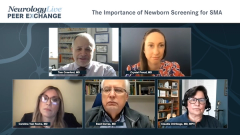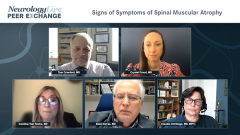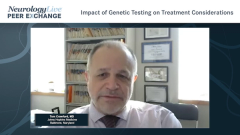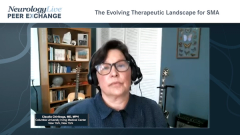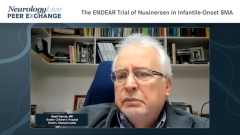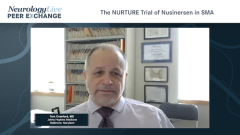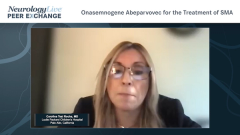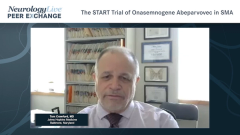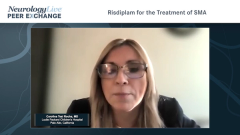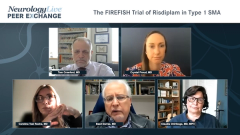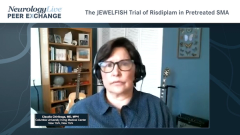
The FIREFISH Trial of Risdiplam in Type 1 SMA
Basil Darras, MD discusses the FIREFISH trial of risdiplam in infants with type 1 symptomatic SMA and comments on the difficulty of comparing agents when trials have had different enrollment criteria.
Episodes in this series

Crystal Proud, MD: You mentioned that some of our guests here today have participated in the clinical trials, so I would like to turn to Basil and ask you to help us navigate the results from the FIREFISH clinical trial.
Basil Darras, MD: I’d be happy to. The FIREFISH study was a 12-month and then 24-month efficacy and safety study of risdiplam in infants with SMA [spinal muscular atrophy] type 1. There was a part 1 and a part 2. Part 1 was more of a dose-finding and safety PK/PD [pharmacokinetics/pharmacodynamics] study. Part 2, which had 41 infants enrolled, was more about efficacy and safety. The primary end point was the proportion of infants sitting without support for at least 5 seconds, as defined by the Bayley Scales of Infant and Toddler Development at month 12. The secondary end points included the proportion of infants who were sitting without support for at least 30 seconds. I would like to remind you that in the STR1VE study, the duration of sitting was defined at 30 seconds. They also included the proportion of infants who achieved a score of more than 40 on the CHOP-INTEND [Children’s Hospital of Philadelphia Infant Test of Neuromuscular Disorders] scale. The achievement of motor milestone was measured by the HINE-2 [Hammersmith Infant Neurological Examination Module 2] scale. They considered the proportion of infants without permanent ventilation and also the proportion of infants who were able to swallow and feed orally, which is another important milestone. At the end, they also considered the number of hospitalizations.
These babies were treated somewhat late; their median age was 5.3 months. It seems that the survival rate was pretty good; it was up in the 90s—93% were alive. About 83% were event free, in terms of ventilation. Sixty one percent of these patients were able to sit without support for at least 5 seconds at month 24, as measured by the Bayley Scales of Infant and Toddler Development; 95% were able to swallow after 24 months of treatment; 34% of these infants did not require hospitalization at all during the 24 months of the treatment. Coming to the 30-second sitting milestone—that was 17% at month 12; at month 24, 44% of the infants were able to sit without support for at least 30 seconds. The CHOP-INTEND scores improved significantly. What is important to mention is, in addition to the survival, which seemed to be high, as I said, the adverse events, most of them seem to be related to the underlying disease. There was no evidence of liver dysfunction or bone marrow dysfunction in all these babies who were treated in the FIREFISH study but also in the SUNFISH and the JEWELFISH studies. Something we were concerned about—the eyes—they were very intense in terms of doing some ophthalmological monitoring, which showed no evidence of retinal damage in the patients who participated in these studies. This is the reason we do not see any FDA warnings in the risdiplam label. It is also important to notice that pneumonia seemed to decline 3-fold, when you compare the first 12 months versus the last 12 months. The incidence of pneumonia hospitalization declines substantially.
This is a little summary of the FIREFISH study. It seems to be effective. It has an advantage in the area of swallowing and diminishing the number of hospitalizations. I think that, given its systemic distribution, there might be benefits that will take a number of years before we realize them. The SMN protein is important in other organs. It is expressed everywhere in the body. Although we don’t see obvious dysfunction, I think that increasing the SMN protein systemically will be an additional benefit to our patients who receive this medication orally. We have not used it extensively. Most of the patients who decided to inquire about risdiplam were somewhat older, people who didn’t want to get spinal taps, for example. There were a few patients who switched from nusinersen to risdiplam, but it hasn’t been a high number so far. I do not have a lot of post-approval experience to be able to say something reliable about efficacy. The safety, so far, seems to be maintained, and as others said, trying to compare these interventions is very hard because the enrollment criteria have been quite different.
Crystal Proud, MD: Thank you for watching this NeurologyLive® Peer Exchange. If you enjoyed the content, please subscribe to our e-newsletters to receive upcoming Peer Exchanges and other great content right in your inbox.
Transcript Edited for Clarity
Newsletter
Keep your finger on the pulse of neurology—subscribe to NeurologyLive for expert interviews, new data, and breakthrough treatment updates.

